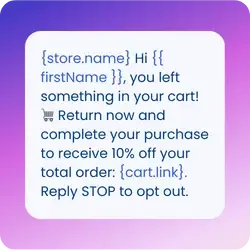SMS Short Code
An SMS short code is a 5 to 6-digit phone number used to send and receive SMS or MMS messages. These codes are designed for high-volume, high-speed messaging and are most commonly used for:
Users can interact with short codes by texting keywords (e.g., “HELP” or “STOP”) for immediate automated SMS responses. In contrast, an SMS long code is a standard 10-digit number that supports two-way messaging, making it ideal for conversational or lower-volume communication.
What an SMS Short Code Provides
High Throughput: Send thousands of messages per second, ideal for peak-volume periods like flash sales, vote tallies, or emergency broadcasts.
Brand Recognition: Short codes are easier to remember than full-length numbers and can help build brand trust over time.
SMS Keyword Engagement: Enable users to respond with intuitive, memorable commands like “JOIN” or “INFO,” and even incorporate emoji in SMS for stronger engagement.
Why SMS Short Codes Matter
Time-Critical Messaging
When seconds matter, like sending OTPs, emergency notifications, or limited-time offers, short codes deliver at speed.
Engagement and Compliance
Short codes typically require carrier vetting and opt-in processes, helping maintain compliance with regulations while boosting user engagement.
Broad Use Cases
From political SMS marketing campaigns to bank alerts, retail promotions, and public health messages, short codes are trusted for important communications.
SMS Short Codes in Australia
10DLC vs Short Code
10DLC numbers (10-digit long codes) are restricted to lower throughput and require campaign registration via The Campaign Registry.
Short codes offer superior speed and higher deliverability, especially for marketing and security use cases.
Short codes must also be registered and approved, but they support larger-scale outreach and interactive campaigns with keyword functionality.
SMS Throughput
10DLC can send around 15–60 messages per second, depending on carrier and vetting score.
Short codes can send hundreds to thousands per second, making them ideal for nationwide campaigns.
SMS Marketing
Use scheduling tools, SMS templates and bulk contact upload to send SMS broadcasts.
 Explore SMS Marketing
Explore SMS Marketing 








